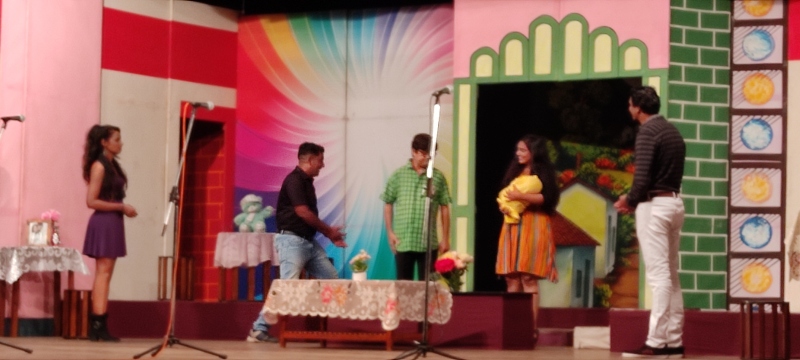Tiatrs have restarted after a 19-month break, and audiences have started cautiously returning to watch their favourite actors and actresses. Our review team sets out once again to do a microscopic analysis of the various segments of tiatrs. It is our constant endeavour to be honest to our readers, and give a fair portrayal of every tiatr reviewed by our team without any extravagant biases or unfair criticisms. We hope directors, producers, actors and other support staff take these reviews in the true spirit and professionalism. It will be our constant endeavour to take tiatrs to greater heights.

Story
This tiatr centres around the doubting husband regarding the paternity of his infant child. The couple is happily married but the advent of the child in the womb of the wife corresponds with the arrival of a celebrity neighbour and the entire drama starts. With the husband finding no similarities striking between the child and him, the doubts catch flames. The closeness of the wife to the neighbour and her singing praises of his talents further compounds the problem which is finally settled through some unrealistic ending.
Script
The script has good suspense but the dialogues are weak. It looks as if it is a translation or adaptation of a drama. The sequences that follow in the next scene too are not a step ahead but more or less a continuation of the previous scene. There is little comedy incorporated in the main story but the main comedy flow is outside the main storyline.
Acting
The tiatr has a talented team of tiatrists acting and all combined give a great performance. Scully D’Souza has portrayed the role of the glamourous wife with ease. Wily Silveira overacts and exaggerates in the first half but picks up steam in the second half and gets convincing. Vishal Gawas is natural in the role of the choreographer neighbour celebrity. He has fewer dialogues and footfall on stage but gives his best. The comedy trio of Prince Jacob, Com Domnic and Meena Goes is at its best. The script had little or few laughs aloud punches but the timing and mannerisms of the trio brought out great laughter from the audience. Aston too chips in support but could not match the temperament of the trio. Tracy and Konkani filmstar Fermino Goes too are seen in a cameo but they had nothing major to offer.
Music
The band led by Seby Moraes was outstanding. There are interesting and meaningful solos by Scully D’Souza, Simran Vas, Rosario de Benaulim, Seby de Divar. A romantic duet by Vishal Gawas and Tracy Dias was very catchy and soothing. A song by Rosario and Simran featured but it cannot be called a duet as there was no interaction to make it a variety song nor was it a choral song as there was no harmony to it. The pick of the songs in the drama was a choral quartet Bhumiputra sung by Meena, Prince Jacob, Com Domnic and Aston Pires. The song is well composed and sung too. But, though choral in nature, had nothing in harmony.
Comedy
Unlike the comedy in the newly released tiatrs of this season, the comedy of the tiatr has a link to the main story and is presented out of the scenes too. The comedy is decent and clean. Prince Jacob gives proof of why he was crowned and given the title of the comedy Prince of the Konkani stage. Com Domnic of the ‘Hoddo Bhakru’ fame is natural and have a great comedy timing. The charming Meena Goes is the darling on stage. She goes well under the skin of the character and brings out good laughing moments. Aston has very little to offer but the top trio overshadows his performance.
Backstage
The sets suggest that the performance is not a tiatr as the same sets are used for different locales. The sitting props were again square boxes with no chairs or sofas. This gives credence to the thought that the story of the tiatr is borrowed from a drama. There was a good background score. The properties on stage too were well managed. The lights design and execution were effective.
Direction
There was a semblance of direction visible in the tiatr, but more work needs to be done in this regard. After long, artistes were not seen pushing their dialogue delivery towards the microphone.
Once again watching the tiatr a question is raised and discussed in the audience. What is the form of presentation of songs? Just a male and female singing a song together can be clubbed as a duet? Or a non-interactive song by four artistes be called a quartet? Does the writer or director know the essence of tiatr? Or whatever they think is sellable is brought up on stage and given in the garb of tiatr? Is it not the duty of the Tiatr Academy of Goa to look into this aspect? A thorough and conscientious thought in this regard is the cry of the day!